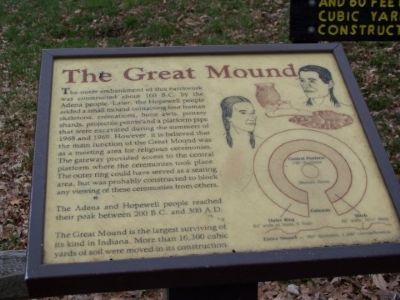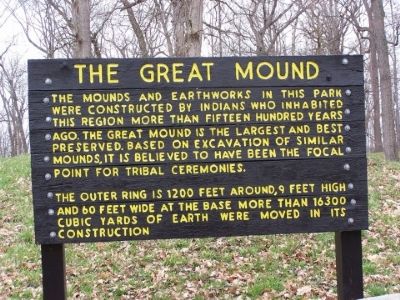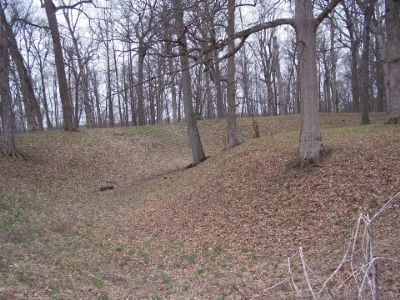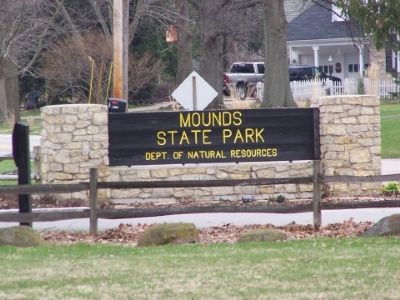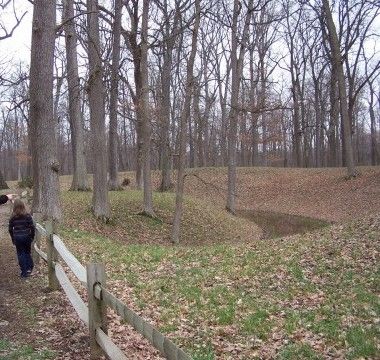Anderson in Madison County, Indiana — The American Midwest (Great Lakes)
The Great Mound
The outer embankment of this earthwork was constructed about 160 B.C. by the Adena people. Later, the Hopewell people added a small mound containing four human skeletons, cremations, bone awls, pottery shards, projectile points and a platform pipe that were excavated during the summers of 1968 and 1969. However, it is believed that the main function of the Great Mound was as a meeting area for religious ceremonies. The gateway provided access to the central platform where the ceremonies took place. The outer ring could have served as a seating area, but was probably constructed to block any viewing of these ceremonies from others.
The Adena and Hopewell people reached their peak between 200 B.C. and 300 A.D.
The Great Mound is the largest surviving of its kind in Indiana. More than 16,300 cubic yards of soil were moved in its construction.
Erected 1930 by Department of Natural Resources.
Topics. This historical marker is listed in this topic list: Native Americans. A significant historical year for this entry is 1968.
Location. 40° 5.838′ N, 85° 37.235′ W. Marker is in Anderson, Indiana, in Madison County. Marker can be reached from Mounds Road (Road 232) east of South Rangeline Road. Marker is located inside Mounds State Park. Touch for map. Marker is at or near this postal address: 4306 Mounds State Park Road, Anderson IN 46017, United States of America. Touch for directions.
Other nearby markers. At least 8 other markers are within 2 miles of this marker, measured as the crow flies. The Mounds Dugout Canoe (about 600 feet away, measured in a direct line); Indiana State Parks: the First 100 Years (about 700 feet away); Native American Memorial (about 700 feet away); The Bronnenberg House (approx. 0.2 miles away); The Bronnenberg Family (approx. 0.2 miles away); a different marker also named The Bronnenberg House (approx. 0.2 miles away); The Circle Mound (approx. 0.4 miles away); The Moravian Mission (approx. 1.4 miles away). Touch for a list and map of all markers in Anderson.
Also see . . . Mounds State Park. Indiana Department of Natural Resources website entry (Submitted on October 3, 2021, by Larry Gertner of New York, New York.)
Additional commentary.
1. Text on Photo No. 2
The mounds and earthworks in this park were constructed by Indians who inhabited this region more than fifteen hundred years ago. The Great Mound is the largest and best preserved based on excavation of similar mounds. It is believed to have been the focal point for tribal ceremonies.
The outer ring is 1200 feet around, 9 feet high and 60 feet wide at the base. More than 16300 cubic yards of earth were moved in its construction.
— Submitted June 22, 2007.
Credits. This page was last revised on October 3, 2021. It was originally submitted on June 22, 2007, by M. Bowyer of Indianapolis, Indiana. This page has been viewed 2,994 times since then and 62 times this year. Photos: 1, 2, 3, 4, 5. submitted on June 22, 2007, by M. Bowyer of Indianapolis, Indiana. • J. J. Prats was the editor who published this page.
